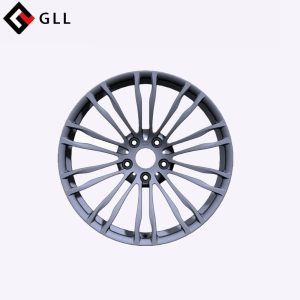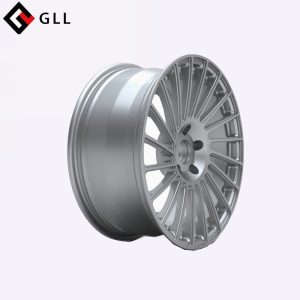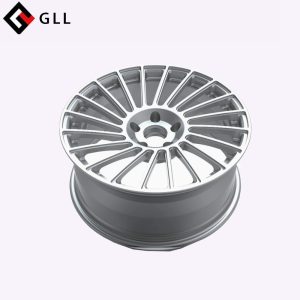


The cornerstone of our GLL custom forged wheels lies in its exclusive use of 6061-T6 aviation-grade aluminum alloy. Compared with the A356.2 aluminum alloy used in traditional cast wheels, the tensile strength of 6061-T6 alloy is increased by 30%, the yield strength is increased by 45%, and the density is lower (2.7g/cm³ vs 2.86g/cm³), achieving a perfect balance between "lightweight" and "high strength".
This material property is particularly critical in extreme driving scenarios: for example, in continuous curves, the wheel needs to withstand lateral G forces of more than 1.5 times the weight of the vehicle body, and the rigid design of our GLL wheel can reduce the risk of deformation by 15%; in track day scenarios, its heat dissipation efficiency is 20% higher than that of cast wheels, effectively delaying the thermal decay of the brake system.
Our GLL forging process can be called "the art of metal plastic forming". Through multiple forgings of a 3,000-ton hydraulic press, the aluminum alloy billet forms a fiber streamline distribution under directional stress, and the grain structure is refined to 0.02mm, far exceeding the 0.5mm coarse grain structure of the casting process. This optimization of the microstructure enables the fatigue life of the wheel hub to reach more than 2 million cycles (the national standard requires 500,000 times), which is enough to cope with the high-intensity use of professional racing cars.
After forging, GLL uses a five-axis linkage CNC machine tool for precision machining with an accuracy of up to 0.01mm. This combination of "rough forging and fine carving" not only retains the ultra-high strength of the forged parts, but also achieves the precise restoration of complex shapes - from the multi-spoke Y-shaped design to the racing-specific center lock structure, millimeter-level customization can be achieved through digital modeling.
Our GLL customization service breaks through the traditional shallow customization of "size + color" and builds a data-driven deep customization system:
Vehicle adaptation: Obtain the original vehicle's brake system and suspension geometry data through 3D scanning to ensure that the gap between the wheel hub and the caliper and the tower top is accurate to 1mm;
Performance customization: Adjust parameters such as ET value (offset), PCD (hole distance) according to the needs of the owner, optimize the dynamic relationship between the tire and the wheel arch, and improve aerodynamic efficiency;
Aesthetic design: Provide more than 200 surface treatment solutions (including brushing, milling, electroplating, water transfer, etc.), and support car owners to provide design drafts for 3D modeling verification.
GLL Wheels Hub uses self-designed tests:
Dynamic impact test: 30km/h hitting a 23° slope, deformation ≤2mm.
Salt spray corrosion test: 720 hours of 5% NaCl solution without blistering/flaking.
High temperature durability test: 150℃ for 48 hours, strength attenuation rate <5%
FAQ
Q1: Are GLL wheels suitable for all models?
A: Through 3D scanning of the original car data, it can be adapted to 99% of passenger cars and modified cars, and special models support customized development.
Q2: How long is the customization cycle?
A: 15-20 working days for standard customized models, 30-45 working days for art co-branded models (including design verification).
Q3: Does lightweighting affect durability?
A: The strength of 6061-T6 alloy is higher than that of traditional materials. Combined with the forging process, the weight is reduced by 30% and the life is increased by 4 times.

